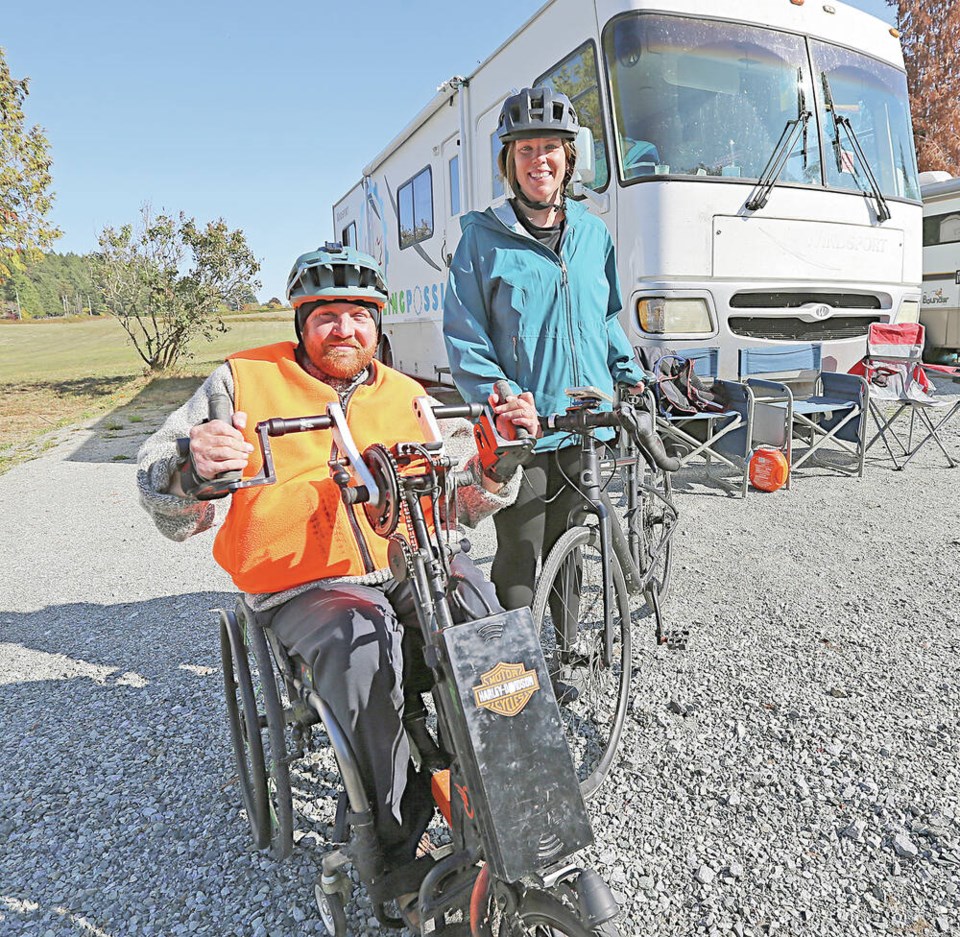After a rogue wave picked him up and smashed him headfirst into the shore, Kevin Mills knew immediately he’d suffered a catastrophic spinal injury because he couldn’t move.
The freak accident happened in 2009 when the then 29-year-old advanced-care paramedic was vacationing with his wife, Heather, in Cuba.
“I was completely paralyzed. As a paramedic, I knew what had happened and how bad it was. Even as I lay there, my training kicked in,” said Mills, who recalls telling the lifeguard attending to him that he was placing the cervical collar on him incorrectly.
Mills was diagnosed with a C4 spinal injury, one of the most severe. “All I could do was shrug,” said Mills, now 43.
After surgery, he was upgraded to C6, which meant he had the use of his shoulders, biceps and wrists.
Before his injury, he’d been an active person who ran long distances, free-dived and rock-climbed. After he got out of the hospital, he turned to hand-cycling to stay active for both his physical and mental health.
About a year after his accident, he successfully completed a half-marathon in a wheelchair.
His injury recovery trainer, Nikki Davenport, eventually suggested he was fit enough to handcycle across Canada in a wheelchair.
They came up with the idea of documenting the trip, mapping a route across the country that people using any mobility aid could follow.
On May 24, the two set off from Cape Spear, Newfoundland. Now, after more than 7,400 kilometres, they’re set to conclude their trek in Victoria today.
How does a quadriplegic man cycle across the country? It takes ingenuity and drive — plus the right equipment.
Mills is using a Batec, an add-on one-wheel hand cycle that attaches to the front of a manual wheelchair.
His arms are strapped into the pedals, controlling his forward motion — he uses both arms simultaneously. For braking, he simply pulls back.
He has enough upper mobility to steer the contraption, which uses a hitch-like mechanism to attach to the wheelchair.
While Mills was able to work around his physical limitations, there were other obstacles he had little control over.
“The first thing you notice while following a bike lane is that some of them are too narrow for a wheelchair,” said Mills, who calls Newmarket, Ont. home.
“Most highways have ‘rumble’ strips on the shoulder. When the bike lanes are too narrow, it means you’ll need to straddle the strips, as there may not be enough room on the right side of them, putting some of you exposed to traffic.”
He said the most accommodating bike infrastructure was in the province of Quebec, as well as in Vancouver.
He was accompanied on his journey by a recreational vehicle, which would go ahead to a pre-arranged campsite or RV park. Even though he had a guaranteed place to stay, it was often difficult to find accessible showers.
One of the facilities he singled out for praise was Gros Morne National Park in Newfoundland, where an all-terrain wheelchair is available at no charge from the visitor centre.
Throughout his trip, accompanied by Davenport on a regular bicycle, he never thought of quitting, he said.
“But there were days I just didn’t feel like biking,” he said.
He said he found cycling through the prairies the toughest, as the road just seemed to go on forever as he battled a headwind.
His spirits picked up when he finally reached the mountains, because “they were so beautiful.”
He would typically cover 160 kilometres a day, generally taking between six to seven hours between campsites.
Mills and Davenport started a non-profit called Pedalling Possibilities for the trip, promoting the importance of activity-based therapy. The charity collected money to make the journey possible, and the plan is for anything left over to go toward purchasing adaptive gear for others.
Along the way, their story was picked up by Canadian Reader, a current-events resource for students Grade 3 and up, and Mills was invited to tell his story to students at two schools, one in Vancouver and the other in Nanaimo.
“The intention had always been to inspire and share my experience, giving confidence to others,” said Mills, who has already received invitations to speak in other schools when he returns home. “We had never planned for schools. It was a very nice outcome.”
Mills will be met in Victoria by his wife, Heather, his parents and sister, who have all flown out to witness the conclusion of his journey. They will be joined by an aunt and cousins from B.C and the U.S.
The plan is to finish his cross-country journey with a ceremony at Ogden Point at noon today.
“Ogden Point is a special spot for me, as it’s where I would go scuba diving when I was in Victoria.”
For more information, go to .
>>> To comment on this article, write a letter to the editor: [email protected]




